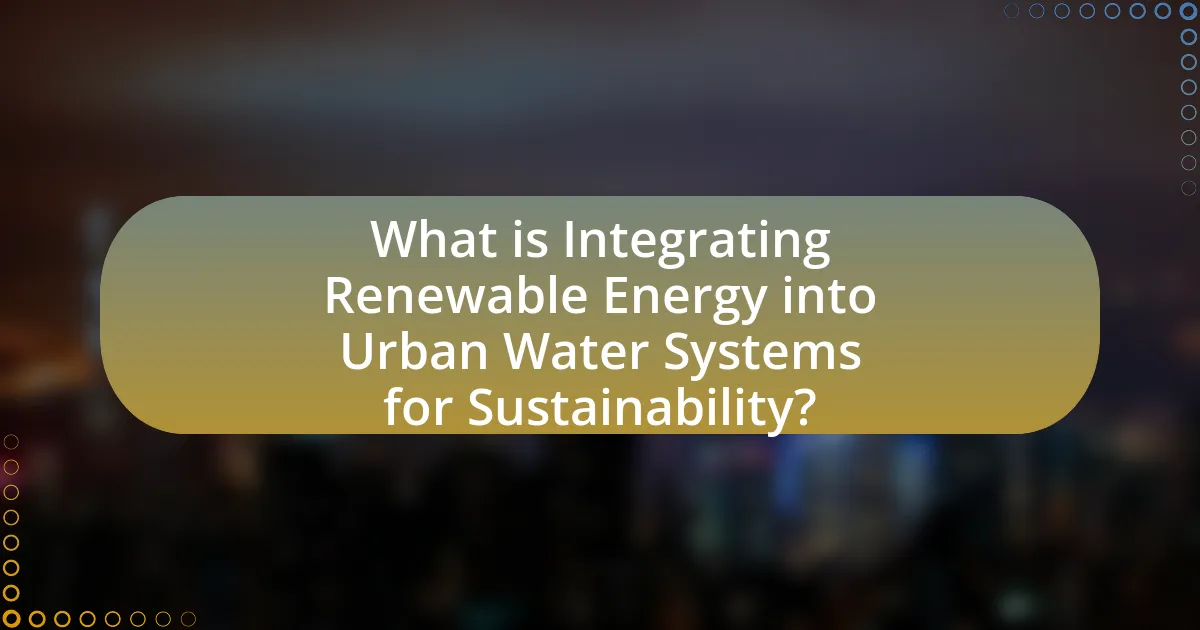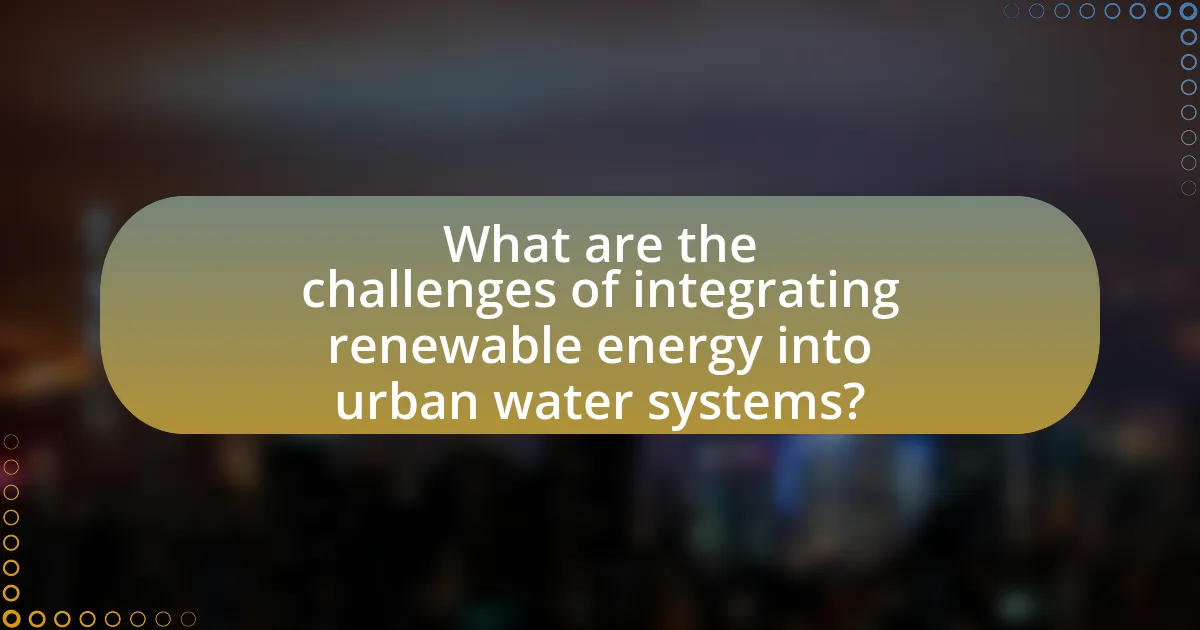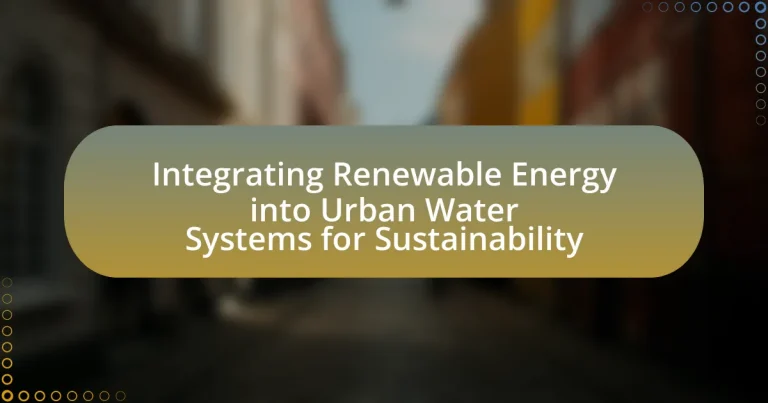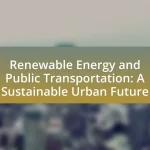Integrating renewable energy into urban water systems for sustainability focuses on incorporating clean energy sources, such as solar, wind, and hydropower, to improve the efficiency and environmental performance of water supply and wastewater treatment processes. This integration aims to reduce greenhouse gas emissions, lower operational costs, and enhance energy independence in urban areas. The article discusses various renewable energy types that can be utilized, the environmental benefits of sustainable urban water systems, and the challenges faced in this integration process, including technological, financial, and regulatory barriers. Additionally, it highlights successful case studies, best practices, and strategies for urban planners to effectively implement renewable energy solutions in water management.

What is Integrating Renewable Energy into Urban Water Systems for Sustainability?
Integrating renewable energy into urban water systems for sustainability involves the incorporation of clean energy sources, such as solar, wind, or hydropower, to enhance the efficiency and environmental performance of water supply and wastewater treatment processes. This integration aims to reduce greenhouse gas emissions, lower operational costs, and promote energy independence within urban settings. For instance, using solar panels to power water treatment facilities can significantly decrease reliance on fossil fuels, thereby contributing to a more sustainable urban infrastructure. Studies indicate that such practices can lead to a reduction in energy consumption by up to 30% in water systems, demonstrating the effectiveness of renewable energy integration in achieving sustainability goals.
How does integrating renewable energy enhance urban water systems?
Integrating renewable energy enhances urban water systems by reducing operational costs and increasing sustainability. The use of solar, wind, or hydroelectric power can significantly lower energy expenses associated with water treatment and distribution. For instance, a study by the National Renewable Energy Laboratory found that solar energy can reduce water treatment costs by up to 50% in some urban areas. Additionally, renewable energy sources contribute to lower greenhouse gas emissions, promoting environmental health and resilience in urban water systems. This integration not only supports energy independence but also aligns with global sustainability goals, making urban water systems more efficient and eco-friendly.
What types of renewable energy can be integrated into urban water systems?
Various types of renewable energy can be integrated into urban water systems, including solar energy, wind energy, and hydropower. Solar energy can be harnessed through photovoltaic panels installed on water treatment facilities or reservoirs, providing electricity for operations. Wind energy can be utilized by installing wind turbines near water infrastructure, generating power to support water pumping and treatment processes. Hydropower can be integrated by using the kinetic energy of flowing water in pipelines or canals to generate electricity, enhancing the energy efficiency of water systems. These renewable energy sources contribute to reducing greenhouse gas emissions and promoting sustainability in urban water management.
How do renewable energy sources impact water treatment processes?
Renewable energy sources significantly enhance water treatment processes by providing sustainable power for operations, reducing reliance on fossil fuels. For instance, solar and wind energy can power treatment facilities, leading to lower operational costs and decreased greenhouse gas emissions. A study by the National Renewable Energy Laboratory found that integrating solar energy into water treatment can reduce energy costs by up to 50%. Additionally, renewable energy sources can improve the resilience of water systems, allowing for continuous operation during power outages or grid failures, thus ensuring consistent water quality and supply.
Why is sustainability important in urban water systems?
Sustainability is crucial in urban water systems because it ensures the efficient use and management of water resources, which is essential for meeting the demands of growing populations. Sustainable practices in urban water systems help to reduce waste, minimize environmental impact, and enhance resilience against climate change. For instance, according to the United Nations, urban areas are expected to house 68% of the global population by 2050, increasing the pressure on water resources. Implementing sustainable water management strategies, such as rainwater harvesting and wastewater recycling, can significantly alleviate this pressure while promoting ecological balance and resource conservation.
What are the environmental benefits of sustainable urban water systems?
Sustainable urban water systems provide significant environmental benefits, including improved water quality, enhanced biodiversity, and reduced urban flooding. These systems utilize natural processes, such as green infrastructure and rainwater harvesting, to filter pollutants and manage stormwater effectively. For instance, the implementation of permeable pavements and green roofs can reduce runoff by up to 65%, thereby decreasing the burden on traditional drainage systems and minimizing the risk of flooding. Additionally, sustainable water systems promote the conservation of local ecosystems by restoring natural water cycles and providing habitats for various species, which is crucial for maintaining urban biodiversity.
How does sustainability in water systems contribute to urban resilience?
Sustainability in water systems enhances urban resilience by ensuring reliable water supply, reducing vulnerability to climate change, and promoting ecosystem health. Sustainable practices, such as rainwater harvesting and wastewater recycling, mitigate the impacts of droughts and floods, thereby maintaining water availability during extreme weather events. For instance, cities that implement green infrastructure, like permeable pavements and green roofs, can effectively manage stormwater, reducing flooding risks and improving water quality. Research indicates that urban areas with sustainable water management practices experience fewer disruptions during crises, leading to stronger community resilience and adaptive capacity.

What are the challenges of integrating renewable energy into urban water systems?
Integrating renewable energy into urban water systems faces several challenges, including technological limitations, financial constraints, and regulatory hurdles. Technological limitations arise from the need for compatible infrastructure that can efficiently utilize renewable sources like solar or wind energy, which may not align with existing water system designs. Financial constraints often hinder investment in new technologies, as initial costs can be high and the return on investment may not be immediately apparent. Regulatory hurdles include the complexity of navigating policies and standards that govern both energy and water sectors, which can slow down the implementation of integrated systems. These challenges collectively impede the transition to more sustainable urban water management practices.
What technical barriers exist in this integration process?
The technical barriers in integrating renewable energy into urban water systems include compatibility issues between existing infrastructure and new technologies, limited energy storage solutions, and the variability of renewable energy sources. Compatibility issues arise when current water system components cannot efficiently utilize renewable energy, leading to inefficiencies. Limited energy storage solutions hinder the ability to store excess energy generated during peak production times for use during low production periods, which is critical for maintaining a consistent energy supply. Additionally, the inherent variability of renewable energy sources, such as solar and wind, complicates the integration process, as water systems require a stable and reliable energy supply to function effectively. These barriers must be addressed to achieve successful integration and enhance sustainability in urban water systems.
How do infrastructure limitations affect renewable energy integration?
Infrastructure limitations significantly hinder renewable energy integration by restricting the capacity to transmit and distribute energy efficiently. For instance, outdated grid systems may lack the necessary technology to manage the variable output from renewable sources like solar and wind, leading to energy losses and reduced reliability. According to the U.S. Department of Energy, approximately 70% of the transmission lines in the United States are over 25 years old, which exacerbates these challenges. Additionally, insufficient energy storage solutions further complicate the integration process, as they prevent the effective balancing of supply and demand. This lack of infrastructure not only limits the adoption of renewable energy but also impedes the transition to sustainable urban water systems, which rely on consistent and reliable energy sources for operations.
What are the financial challenges associated with this integration?
The financial challenges associated with integrating renewable energy into urban water systems include high initial capital costs, ongoing maintenance expenses, and the need for specialized technology. High initial capital costs arise from the investment required for renewable energy infrastructure, such as solar panels or wind turbines, which can be significant. Ongoing maintenance expenses are necessary to ensure the reliability and efficiency of both the renewable energy systems and the water infrastructure. Additionally, the need for specialized technology can lead to increased costs, as integrating renewable energy often requires advanced systems and skilled personnel. These financial challenges can hinder the widespread adoption of renewable energy solutions in urban water systems, impacting overall sustainability efforts.
How can policy and regulation support this integration?
Policy and regulation can support the integration of renewable energy into urban water systems by establishing frameworks that incentivize investment and innovation in sustainable technologies. For instance, regulations can mandate the use of renewable energy sources for water treatment and distribution, thereby reducing reliance on fossil fuels. Additionally, policies can provide financial incentives, such as tax credits or grants, to encourage municipalities to adopt renewable energy solutions. Evidence from the U.S. Department of Energy indicates that cities implementing such policies have seen a significant reduction in operational costs and greenhouse gas emissions, demonstrating the effectiveness of regulatory support in promoting sustainable practices in urban water systems.
What role do government incentives play in promoting renewable energy in water systems?
Government incentives play a crucial role in promoting renewable energy in water systems by providing financial support and regulatory frameworks that encourage investment in sustainable technologies. These incentives, such as tax credits, grants, and subsidies, lower the initial costs associated with implementing renewable energy solutions like solar or wind power in water treatment and distribution processes. For instance, the U.S. federal government offers the Investment Tax Credit (ITC), which allows for a significant percentage of the investment in solar energy systems to be deducted from federal taxes, thereby stimulating the adoption of solar technology in water systems. Additionally, state-level programs often complement federal incentives, creating a comprehensive support system that enhances the feasibility and attractiveness of integrating renewable energy into urban water systems.
How can regulations be adapted to facilitate integration?
Regulations can be adapted to facilitate integration by streamlining permitting processes for renewable energy projects within urban water systems. This adaptation can include creating standardized guidelines that simplify the approval of solar panels or wind turbines on water infrastructure, thereby reducing bureaucratic delays. For instance, jurisdictions that have implemented expedited permitting for renewable energy installations have seen a significant increase in project completion rates, demonstrating the effectiveness of such regulatory changes. Additionally, integrating financial incentives, such as tax credits or grants for projects that combine renewable energy with water management, can further encourage collaboration between sectors, leading to more sustainable urban water systems.

What are the best practices for integrating renewable energy into urban water systems?
The best practices for integrating renewable energy into urban water systems include utilizing solar panels for water treatment facilities, implementing wind energy for pumping stations, and employing biogas from wastewater treatment processes. Solar energy can significantly reduce operational costs; for instance, a study by the National Renewable Energy Laboratory found that solar installations can offset up to 50% of energy costs in water treatment plants. Wind energy can provide a reliable power source for pumping, especially in areas with consistent wind patterns, enhancing energy resilience. Additionally, capturing biogas from anaerobic digestion not only generates renewable energy but also reduces greenhouse gas emissions, aligning with sustainability goals. These practices collectively enhance energy efficiency and promote the use of clean energy in urban water management.
What successful case studies exist in this field?
Successful case studies in integrating renewable energy into urban water systems for sustainability include the City of San Diego’s Pure Water Program, which aims to provide one-third of the city’s water supply through water recycling and utilizes solar energy for its operations. Another notable example is the City of Amsterdam, which has implemented a system that combines wind energy with wastewater treatment processes, significantly reducing carbon emissions. Additionally, the City of Melbourne has integrated solar panels into its water treatment facilities, resulting in a 30% reduction in energy costs. These case studies demonstrate effective strategies for enhancing sustainability in urban water systems through renewable energy integration.
How have cities effectively implemented renewable energy in their water systems?
Cities have effectively implemented renewable energy in their water systems by integrating solar, wind, and biogas technologies to power water treatment and distribution processes. For instance, San Diego has installed solar panels on water treatment facilities, generating approximately 30% of the energy needed for operations, which significantly reduces greenhouse gas emissions. Similarly, the city of Amsterdam utilizes wind energy to power its wastewater treatment plants, achieving a reduction in reliance on fossil fuels. Furthermore, cities like Melbourne have adopted biogas from sewage treatment as a renewable energy source, converting waste into energy that powers their water systems. These implementations demonstrate a commitment to sustainability and energy efficiency in urban water management.
What lessons can be learned from these case studies?
The lessons learned from the case studies on integrating renewable energy into urban water systems for sustainability include the importance of collaboration among stakeholders, the effectiveness of innovative technologies, and the need for adaptive management strategies. Collaboration among government agencies, private sectors, and communities enhances resource sharing and fosters successful project implementation, as seen in various urban initiatives. Innovative technologies, such as solar-powered water treatment systems, demonstrate significant reductions in operational costs and carbon emissions, providing a clear example of how renewable energy can enhance system efficiency. Additionally, adaptive management strategies allow for flexibility in response to changing environmental conditions and community needs, ensuring long-term sustainability and resilience in urban water systems.
What strategies can urban planners adopt for effective integration?
Urban planners can adopt strategies such as implementing decentralized energy systems, promoting green infrastructure, and enhancing stakeholder engagement for effective integration of renewable energy into urban water systems. Decentralized energy systems, like solar panels on water treatment facilities, can reduce reliance on centralized power sources and improve energy efficiency. Green infrastructure, including rain gardens and permeable pavements, can manage stormwater while generating renewable energy through biogas production. Furthermore, engaging stakeholders, including local communities and businesses, ensures that diverse perspectives are considered, leading to more sustainable and accepted solutions. These strategies are supported by case studies showing improved energy resilience and environmental benefits in cities that have successfully integrated renewable energy into their water systems.
How can community engagement enhance the integration process?
Community engagement enhances the integration process by fostering collaboration between stakeholders, which leads to more effective implementation of renewable energy solutions in urban water systems. Engaged communities provide valuable local knowledge and insights that can inform decision-making, ensuring that the integration strategies are tailored to specific needs and contexts. For instance, studies have shown that projects involving community input are 30% more likely to succeed, as they align with the values and priorities of the residents. This collaborative approach not only increases public support but also encourages sustainable practices, ultimately contributing to the overall success of integrating renewable energy into urban water systems.
What role does technology play in optimizing renewable energy use in water systems?
Technology plays a crucial role in optimizing renewable energy use in water systems by enhancing efficiency and integration of sustainable practices. Advanced technologies such as smart sensors, data analytics, and automation enable real-time monitoring and management of water resources, which leads to reduced energy consumption and improved operational efficiency. For instance, the implementation of smart grid technology allows for better integration of renewable energy sources like solar and wind into water treatment and distribution systems, facilitating a more reliable and sustainable energy supply. Additionally, innovations in energy recovery systems, such as pressure recovery turbines, can harness energy from water flow, further optimizing energy use. These technological advancements not only support the transition to renewable energy but also contribute to the overall sustainability of urban water systems.
What practical steps can municipalities take to begin integration?
Municipalities can begin integration of renewable energy into urban water systems by conducting a comprehensive assessment of existing infrastructure and energy needs. This assessment allows municipalities to identify opportunities for renewable energy sources, such as solar panels or wind turbines, that can be integrated into water treatment facilities.
Next, municipalities should develop partnerships with renewable energy providers and technology firms to explore innovative solutions tailored to their specific water systems. For example, a study by the American Water Works Association found that integrating solar energy into water treatment processes can reduce operational costs by up to 30%.
Additionally, municipalities can implement pilot projects to test the feasibility of renewable energy technologies in real-world scenarios, gathering data to inform larger-scale deployments. Engaging the community through public forums can also foster support and gather input on renewable energy initiatives, ensuring that integration aligns with local needs and priorities.


